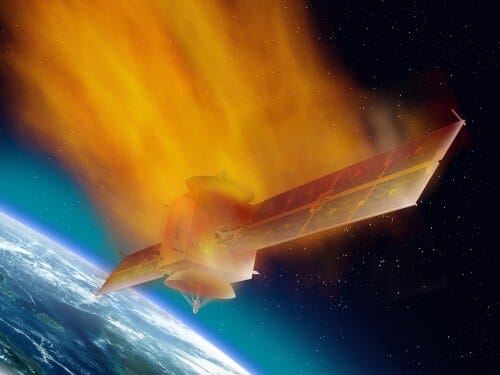The European Space Agency says that it is most likely that this happened over the Pacific Ocean or the Indian Ocean - south of Asia and north of Antarctica. The uncertainty stems from the fact that the exact time of the fall is not known. In any case, most of the path in which the satellite moved toward the end was over the sea

for updates from the previous day (10/11/13)
The following morning's update: while most of the satellite's mass, which weighed 1,100 kg, disintegrated in the atmosphere, it is estimated that 25% of it reached the surface of the earth. An international team from the Interagency Twinning Committee and personnel from the European Space Agency's Space Debris Office monitored the entry of the satellite.
"The one-ton satellite is only a fraction of the 100-150 tons of man-made space objects that enter the Earth's atmosphere every year: says Heiner Klinkard, Director of the European Space Agency's Space Debris Office." According to him, "in the 56 years of space flights, artificial space vehicles with a total weight of 15 tons have penetrated the atmosphere, without even causing injury to a single person."
Update 04:30 Initial estimates are that the few fragments that did not burn up in the atmosphere, landed in the vast area between South Asia and Antarctica. In any case, no country has reported any casualties.
Update 03:45 - The European Space Agency announces that according to the data the satellite crashed, not the exact moment of entering the atmosphere and where exactly it happened. The agency's space debris office will update later.
Update 02:00 - In the last hour, no updates were provided on the European Space Agency website.
Update 00:50 The European Space Agency managed to contact the GOCE spacecraft via the TROLL relay station in Antarctica at 00:42. The temperature of the main computer has reached 80 degrees Celsius and the battery is running at 84 degrees. Contrary to all expectations, the spacecraft's instruments were still working. Contact with GOCE was made once again from the Troll station in Antarctica at 23:42 CET. The central computer temperature is at 80ºC and the battery is at 84ºC. At an altitude of less than 120 km, the spacecraft is – against expectations – still functional.
Update 00:10 - In a short pass over the TROLL ground station that ended at 22:18 Israel time, when the GOCE satellite orbited at an altitude of only 122 kilometers, its systems showed exceptional durability and they provided vital information to the ground station. Using this information, which also included navigation corrections along the route, it was possible to adjust the route and calculate the time of entry into the atmosphere. The current estimates lead to a crash window between 00:50 and 02:50 (the times were calculated according to Israel time, the ESA website shows the times in Central European Time A.B.). The most likely is that the crash area according to the calculated route will pass mainly in the Atlantic Ocean and the Indian Ocean. The European Space Agency will make another communication attempt with the satellite, parts of whose main computer are already operating at a temperature of over 80 degrees in order to provide a more accurate forecast and also extract scientific data from such a low altitude (as I recall, the spacecraft measured the Earth's gravity field and the lower the altitude, the better the results And this is also the reason for the rapid erosion of the runway after it ran out of fuel in October). The additional data will also reduce the uncertainties of the atmospheric entry forecast. More about the satellite see:
While most of the mass of the satellite, which weighed 1,100 kg, disintegrated in the atmosphere, it is estimated that 25% of it reached the surface of the earth. An international team from the Interagency Twinning Committee and personnel from the European Space Agency's Space Debris Office monitored the entry of the satellite.
"The one-ton satellite is only a fraction of the 100-150 tons of man-made space objects that enter the Earth's atmosphere every year: says Heiner Klinkard, Director of the European Space Agency's Space Debris Office." According to him, "in the 56 years of space flights, artificial space vehicles with a total weight of 15 tons have penetrated the atmosphere, without even causing injury to a single person."

4 תגובות
The explosion of the satellite in space could cause many more fragments to remain in orbit and endanger future spacecraft.
Cars also roam the roads and every day 3,300 yes three thousand and three hundred people are killed not to mention the tens of thousands of injured and disabled people... in short - life is a dangerous thing!
Couldn't it have been directed in time (even before it ran out of fuel) for a safe landing in the ocean? Or alternatively, is it not possible to take care in advance (as part of its planning) that as soon as such a satellite is about to end its life, it will be broken up into small parts (for example by an explosion as a result of a command from the ground) that will ensure that they burn up before reaching the ground?
Why every time citizens all over the world have to fear that large pieces of metal might fall on their heads? It is true that the chance of this is slim, but the very thought that such a thing is possible is simply unpleasant and stressful (it is true that airplanes fly above us all the time and they too may fall, but here we are talking about the clear knowledge that large chunks of metal are going to fall to the ground with certainty within a few hours, this is different, And as one of the commenters said on another site - it's almost like a game of Russian roulette that everyone is forced to participate in)